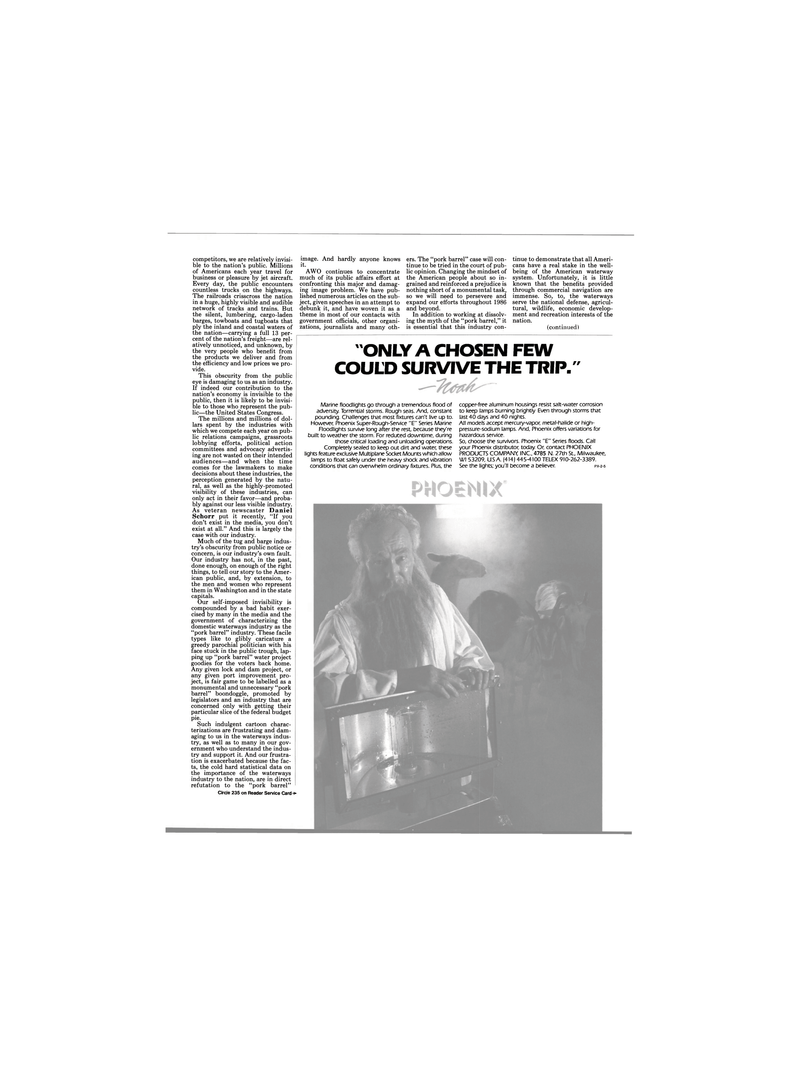
Page 51: of Maritime Reporter Magazine (March 1986)
Read this page in Pdf, Flash or Html5 edition of March 1986 Maritime Reporter Magazine
competitors, we are relatively invisi- ble to the nation's public. Millions of Americans each year travel for business or pleasure by jet aircraft.
Every day, the public encounters countless trucks on the highways.
The railroads crisscross the nation in a huge, highly visible and audible network of tracks and trains. But the silent, lumbering, cargo-laden barges, towboats and tugboats that ply the inland and coastal waters of the nation—carrying a full 13 per- cent of the nation's freight—are rel- atively unnoticed, and unknown, by the very people who benefit from the products we deliver and from the efficiency and low prices we pro- vide.
This obscurity from the public eye is damaging to us as an industry.
If indeed our contribution to the nation's economy is invisible to the public, then it is likely to be invisi- ble to those who represent the pub- lic—the United States Congress.
The millions and millions of dol- lars spent by the industries with which we compete each year on pub- lic relations campaigns, grassroots lobbying efforts, political action committees and advocacy advertis- ing are not wasted on their intended audiences—and when the time comes for the lawmakers to make decisions about these industries, the perception generated by the natu- ral, as well as the highly-promoted visibility of these industries, can only act in their favor—and proba- bly against our less visible industry.
As veteran newscaster Daniel
Schorr put it recently, "If you don't exist in the media, you don't exist at all." And this is largely the case with our industry.
Much of the tug and barge indus- try's obscurity from public notice or concern, is our industry's own fault.
Our industry has not, in the past, done enough, on enough of the right things, to tell our story to the Amer- ican public, and, by extension, to the men and women who represent them in Washington and in the state capitals.
Our self-imposed invisibility is compounded by a bad habit exer- cised by many in the media and the government of characterizing the domestic waterways industry as the "pork barrel" industry. These facile types like to glibly caricature a greedy parochial politician with his face stuck in the public trough, lap- ping up "pork barrel" water project goodies for the voters back home.
Any given lock and dam project, or any given port improvement pro- ject, is fair game to be labelled as a monumental and unnecessary "pork barrel" boondoggle, promoted by legislators and an industry that are concerned only with getting their particular slice of the federal budget pie.
Such indulgent cartoon charac- terizations are frustrating and dam- aging to us in the waterways indus- try, as well as to many in our gov- ernment who understand the indus- try and support it. And our frustra- tion is exacerbated because the fac- ts, the cold hard statistical data on the importance of the waterways industry to the nation, are in direct refutation to the "pork barrel"
Circle 235 on Reader Service Card •> image. And hardly anyone knows it.
AWO continues to concentrate much of its public affairs effort at confronting this major and damag- ing image problem. We have pub- lished numerous articles on the sub- ject, given speeches in an attempt to debunk it, and have woven it as a theme in most of our contacts with government officials, other organi- zations, journalists and many oth- ers. The "pork barrel" case will con- tinue to be tried in the court of pub- lic opinion. Changing the mindset of the American people about so in- grained and reinforced a prejudice is nothing short of a monumental task, so we will need to persevere and expand our efforts throughout 1986 and beyond.
In addition to working at dissolv- ing the myth of the "pork barrel," it is essential that this industry con- tinue to demonstrate that all Ameri- cans have a real stake in the well- being of the American waterway system. Unfortunately, it is little known that the benefits provided through commercial navigation are immense. So, to, the waterways serve the national defense, agricul- tural, wildlife, economic develop- ment and recreation interests of the nation. (continued) "ONLY A CHOSEN FEW
COULD SURVIVE THE TRIP. //
Marine floodlights go through a tremendous flood of adversity. Torrential storms. Rough seas. And, constant pounding. Challenges that most fixtures can't live up to.
However, Phoenix Super-Rough-Service "E" Series Marine
Floodlights survive long after the rest, because they're built to weather the storm. For reduced downtime, during those critical loading and unloading operations.
Completely sealed to keep out dirt and water, these lights feature exclusive Multiplane Socket Mounts which allow lamps to float safely under the heavy shock and vibration conditions that can overwhelm ordinary fixtures. Plus, the copper-free aluminum housings resist salt-water corrosion to keep lamps burning brightly. Even through storms that last 40 days and 40 nights.
All models accept mercury-vapor, metal-halide or high- pressure-sodium lamps. And, Phoenix offers variations for hazardous service.
So, choose the survivors. Phoenix "E" Series floods. Call your Phoenix distributor, today. Or, contact PHOENIX
PRODUCTS COMPANY INC., 4785 N. 27th St., Milwaukee,
Wl 53209, U.SA. (414) 445-4100 TELEX 910-262-3389.
See the lights; you'll become a believer. px-2-5

 50
50

 52
52
